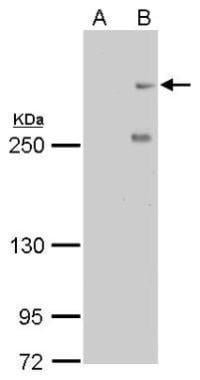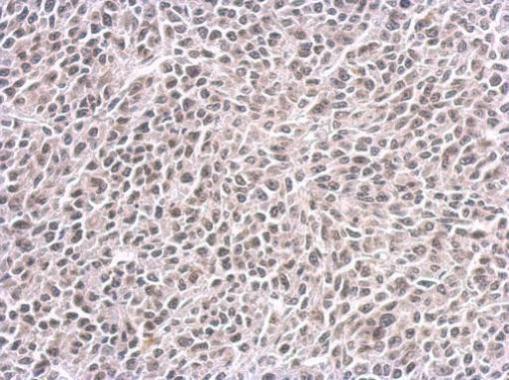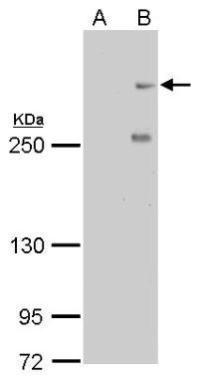| Weight | 1 lbs |
|---|---|
| Dimensions | 9 × 5 × 2 in |
| host | mouse |
| isotype | IgG2a |
| clonality | monoclonal |
| concentration | 1 mg/mL |
| applications | ICC/IF, WB |
| reactivity | Mitosin |
| available sizes | 100 µg |
mouse anti-Mitosin monoclonal antibody (14C10) 2862
$503.00
Antibody summary
- Mouse monoclonal to Mitosin
- Suitable for: WB,ICC/IF,IHC-P,IHC-Fr,FACS,IP
- Isotype: IgG2a
- 100 µg
mouse anti-Mitosin monoclonal antibody (14C10) 2862
| antibody |
|---|
| Tested applications WB,IHC,IHC,ICC/IF |
| Recommended dilutions Immunoblotting: use at 1-10 ug/mL. Immunoprecipitation: use at 1-10 ug/mL. Immunohistochemistry: use at 10 ug/mL with frozen or paraffin-embedded sections. Positive controls: Human tissue containing rapidly proliferating cells, such as lymphoid germinal centers. |
| Immunogen GST fusion protein expressed in E. coli corresponding to aa 1759-2093 of human mitosin. |
| Size and concentration 100µg and lot specific |
| Form liquid |
| Storage Instructions This antibody is stable for at least one (1) year at -70°C. Avoid multiple freeze-thaw cycles. |
| Storage buffer PBS, pH 7.4 |
| Purity protein affinity purification |
| Clonality monoclonal |
| Isotype IgG2a |
| Compatible secondaries goat anti-mouse IgG, H&L chain specific, peroxidase conjugated polyclonal antibody 5486 goat anti-mouse IgG, H&L chain specific, biotin conjugated, Conjugate polyclonal antibody 2685 goat anti-mouse IgG, H&L chain specific, FITC conjugated polyclonal antibody 7854 goat anti-mouse IgG, H&L chain specific, peroxidase conjugated polyclonal antibody, crossabsorbed 1706 goat anti-mouse IgG, H&L chain specific, biotin conjugated polyclonal antibody, crossabsorbed 1716 goat anti-mouse IgG, H&L chain specific, FITC conjugated polyclonal antibody, crossabsorbed 1721 |
| Isotype control Mouse monocolonal IgG2a - Isotype Control |
| target relevance |
|---|
| Protein names Centromere protein F (CENP-F) (AH antigen) (Kinetochore protein CENPF) (Mitosin) |
| Gene names CENPF,CENPF |
| Protein family Centromere protein F family |
| Mass 357527Da |
| Function FUNCTION: Required for kinetochore function and chromosome segregation in mitosis. Required for kinetochore localization of dynein, LIS1, NDE1 and NDEL1. Regulates recycling of the plasma membrane by acting as a link between recycling vesicles and the microtubule network though its association with STX4 and SNAP25. Acts as a potential inhibitor of pocket protein-mediated cellular processes during development by regulating the activity of RB proteins during cell division and proliferation. May play a regulatory or permissive role in the normal embryonic cardiomyocyte cell cycle and in promoting continued mitosis in transformed, abnormally dividing neonatal cardiomyocytes. Interaction with RB directs embryonic stem cells toward a cardiac lineage. Involved in the regulation of DNA synthesis and hence cell cycle progression, via its C-terminus. Has a potential role regulating skeletal myogenesis and in cell differentiation in embryogenesis. Involved in dendritic cell regulation of T-cell immunity against chlamydia. {ECO:0000269|PubMed:12974617, ECO:0000269|PubMed:17600710, ECO:0000269|PubMed:7542657, ECO:0000269|PubMed:7651420}. |
| Subellular location SUBCELLULAR LOCATION: Cytoplasm, perinuclear region. Nucleus matrix. Chromosome, centromere, kinetochore. Cytoplasm, cytoskeleton, spindle. Note=Relocalizes to the kinetochore/centromere (coronal surface of the outer plate) and the spindle during mitosis. Observed in nucleus during interphase but not in the nucleolus. At metaphase becomes localized to areas including kinetochore and mitotic apparatus as well as cytoplasm. By telophase, is concentrated within the intracellular bridge at either side of the mid-body. |
| Structure SUBUNIT: Interacts with and STX4 (via C-terminus) (By similarity). Interacts (via N-terminus) with RBL1, RBL2 and SNAP25 (By similarity). Self-associates. Interacts with CENP-E and BUBR1 (via C-terminus). Interacts (via C-terminus) with NDE1, NDEL1 and RB1. {ECO:0000250, ECO:0000269|PubMed:17600710, ECO:0000269|PubMed:7642639, ECO:0000269|PubMed:7651420, ECO:0000269|PubMed:9763420}. |
| Post-translational modification PTM: Hyperphosphorylated during mitosis. |
| Involvement in disease DISEASE: Stromme syndrome (STROMS) [MIM:243605]: An autosomal recessive congenital disorder characterized by intestinal atresia, ocular anomalies, microcephaly, and renal and cardiac abnormalities in some patients. The disease has features of a ciliopathy, and lethality in early childhood is observed in severe cases. {ECO:0000269|PubMed:25564561, ECO:0000269|PubMed:26820108}. Note=The disease is caused by variants affecting the gene represented in this entry. |
| Target Relevance information above includes information from UniProt accession: P49454 |
| The UniProt Consortium |
Data
Publications
| pmid | title | authors | citation |
|---|---|---|---|
| We haven't added any publications to our database yet. | |||
Protocols
| relevant to this product |
|---|
| Western blot IHC ICC |
Documents
| # | SDS | Certificate | |
|---|---|---|---|
| Please enter your product and batch number here to retrieve product datasheet, SDS, and QC information. | |||
Only logged in customers who have purchased this product may leave a review.













Reviews
There are no reviews yet.